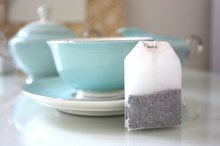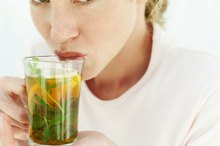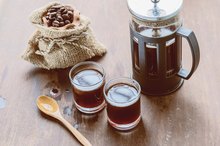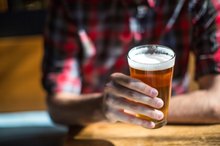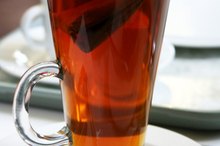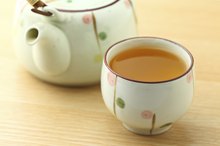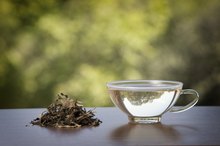What does fact checked mean?
At Healthfully, we strive to deliver objective content that is accurate and up-to-date. Our team periodically reviews articles in order to ensure content quality. The sources cited below consist of evidence from peer-reviewed journals, prominent medical organizations, academic associations, and government data.
- Linus Pauling Institute; Tea; Jane Higdon, Ph.D.; Jan. 2008
- MayoClinic.com; Caffeine Content for Coffee, Tea, Soda and More; Oct. 3, 2009
The information contained on this site is for informational purposes only, and should not be used as a substitute for the advice of a professional health care provider. Please check with the appropriate physician regarding health questions and concerns. Although we strive to deliver accurate and up-to-date information, no guarantee to that effect is made.
Does Red Diamond Tea Have Caffeine in It?
Red Diamond, Inc., originally known as Donovan Provision Company, was established in 1906 by William Fitz Donovan. Based in Birmingham, Alabama, the company provides a variety of tea and coffee blends as well as service programs for the food and beverage industry. According to Neil Bogart, Manufacturing Quality Systems Manager of Red Diamond, Inc., Red Diamond Tea is derived from a blend of leaves from the Camellia sinensis plant, which contains a fair amount of caffeine. Consult with your health care adviser regarding caffeine intake recommendations.
Camellia Sinensis
The University of Maryland Medical Center reports that caffeine is a compound found in a variety of plants, such as the Camellia sinensis leaves utilized for the production of Red Diamond Tea 1. Traditional teas, such as:
- green
- white
- black
- oolong tea
- all derive from the Camellia sinensis plant
Caffeine, which may also be found in cocoa beans and kola nuts, functions as a diuretic and stimulant for the central nervous system.
Caffeine Content
Caffeine in Pekoe Tea
Learn More
Although traditional teas are caffeinated, varying preparation and fermentation methods influence the caffeine content. University of Maryland Medical Center explains that green tea leaves are unfermented, oolong tea leaves are partially fermented, while black tea leaves are completely fermented 1. As such, black tea leaves are reported to have twice or triple the amount of caffeine of green tea leaves. While the ratio of tea leaves utilized in the Red Diamond Tea brand is unknown, Bogart states that an 8 oz. serving of brewed Red Diamond Tea contains approximately 35 mg of caffeine.
- Although traditional teas are caffeinated, varying preparation and fermentation methods influence the caffeine content.
- As such, black tea leaves are reported to have twice or triple the amount of caffeine of green tea leaves.
Preparation
Red Diamond, Inc. provides consumers with the choice of prepared sweet or unsweetened tea as well as tea bags. You can dilute prepared tea with fruit juice or water to lessen the effects of the caffeine. Tea bags containing leaves of the Camellia sinensis plant release most of its caffeine within the first minute of steeping. To reduce the amount of caffeine, simply steep one tea bag in boiling water for one minute prior to disposing the water. Repeat the process a second time to create a partially caffeinated tea. Red Diamond, Inc. also produces a line of decaffeinated teas for individuals wishing to restrict their intakes of caffeine.
- Red Diamond, Inc. provides consumers with the choice of prepared sweet or unsweetened tea as well as tea bags.
Considerations
Lipton Tea and Antioxidants
Learn More
Although tea blends may be labeled as "decaffeinated," MayoClinic.com notes that even decaffeinated teas contain marginal amounts of caffeine. For instance, an 8 oz. serving of decaffeinated black tea contains between 2 to 10 mg of caffeine. The University of Maryland Medical Center considers 250 mg of caffeine a moderate amount 1. Excessive consumption of caffeine may lead to nausea, depression or sleep disorders. Speak with your health care provider regarding diet recommendations for restricting caffeine intake.
- Although tea blends may be labeled as "decaffeinated," MayoClinic.com notes that even decaffeinated teas contain marginal amounts of caffeine.
- The University of Maryland Medical Center considers 250 mg of caffeine a moderate amount 1.
Related Articles
References
- University of Maryland Medical Center; Green Tea; Sept. 20, 2010
- Linus Pauling Institute; Tea; Jane Higdon, Ph.D.; Jan. 2008
- MayoClinic.com; Caffeine Content for Coffee, Tea, Soda and More; Oct. 3, 2009
- Meredith SE, Juliano LM, Hughes JR, Griffiths RR. Caffeine Use Disorder: A Comprehensive Review and Research Agenda. J Caffeine Res. 2013;3(3):114-130. doi:10.1089/jcr.2013.0016
- Richards G, Smith AP. A Review of Energy Drinks and Mental Health, with a Focus on Stress, Anxiety, and Depression. J Caffeine Res. 2016;6(2):49-63. doi:10.1089/jcr.2015.0033
- Brunyé TT, Mahoney CR, Rapp DN, Ditman T, Taylor HA. Caffeine enhances real-world language processing: evidence from a proofreading task. J Exp Psychol Appl. 2012;18(1):95-108. doi:10.1037/a0025851
- Koppelstaetter F, Poeppel TD, Siedentopf CM, et al. Caffeine and cognition in functional magnetic resonance imaging. J Alzheimers Dis. 2010;20 Suppl 1:S71-84. doi:10.3233/JAD-2010-1417
- Harrell PT, Juliano LM. Caffeine expectancies influence the subjective and behavioral effects of caffeine. Psychopharmacology (Berl). 2009;207(2):335-42. doi:10.1007/s00213-009-1658-5
- Lucas M, O'reilly EJ, Pan A, et al. Coffee, caffeine, and risk of completed suicide: results from three prospective cohorts of American adults. World J Biol Psychiatry. 2014;15(5):377-86. doi:10.3109/15622975.2013.795243
- Abdel-Hady H, Nasef N, Shabaan AE, Nour I. Caffeine therapy in preterm infants. World J Clin Pediatr. 2015;4(4):81-93. doi:10.5409/wjcp.v4.i4.81
- American Psychiatric Association. Diagnostic and Statistical Manual of Mental Disorders. 5th edition. Washington DC; 2013.
- Turnbull D, Rodricks JV, Mariano GF, Chowdhury F. Caffeine and cardiovascular health. Regul Toxicol Pharmacol. 2017;89:165-185. doi:10.1016/j.yrtph.2017.07.025
- Centers for Disease Control and Prevention. Alcohol and Caffeine. Updated October 23, 2018.
- Alsunni AA. Energy Drink Consumption: Beneficial and Adverse Health Effects. Int J Health Sci (Qassim). 2015;9(4):468-474.
- Lyngsø J, Ramlau-Hansen CH, Bay B, Ingerslev HJ, Hulman A, Kesmodel US. Association between coffee or caffeine consumption and fecundity and fertility: a systematic review and dose-response meta-analysis. Clin Epidemiol. 2017;9:699-719. doi:10.2147/CLEP.S146496
- U.S. Food and Drug Administration. Pure and Highly Concentrated Caffeine. Updated September 21, 2018.
- National Institute on Drug Abuse. Drugs, Brains, and Behavior: The Science of Addiction. Updated July 2018.
Writer Bio
Stephanie Lee began writing in 2000 with concentration on food, travel, fashion and real estate. She has written for Amnesty International and maintains three blogs. Lee holds a Bachelor of Arts in international relations from the University of California, Irvine, and an M.B.A. from Concordia University.
